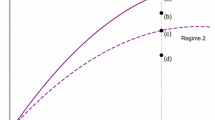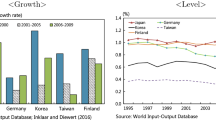Abstract
The paper explores the linkages between labour productivity, innovation and technology spillovers in a panel of manufacturing industries. The roles of R&D, human capital and international trade are considered in stimulating innovation and/or facilitating technology transfer. Using panel-based unit root tests and cointegration analysis, the results indicate the existence of a single long-run equilibrium relation between labour productivity, innovation and technology transfer. Further, R&D, trade and human capital have statistically and, especially the latter, quantitatively important effects on labour productivity both directly via innovation and indirectly as they enhance technology diffusion.
Similar content being viewed by others
References
Abramovitz, M. (1986). Catching Up, Forging Ahead, and Falling Behind. Journal of Economic History 46 (2): 385–406.
Aghion, P., and P. Howitt (1998). Endogenous Growth Theory. Cambridge, Mass.: MIT Press.
Ashenfelter, O., C. Harmon, and H. Oosterbeek (1999). A Review of Estimates of the Schooling/Earnings Relationship, with Tests for Publication Bias. Labor Economics 6 (4): 453–470.
Barro, R., and J. W. Lee (1996). International Measures of Schooling Years and Schooling Quality. American Economic Review 86 (2): 218–223.
Barro, R., and X. Sala-i-Martin (1995). Economic Growth. New York: McGraw-Hill.
Bassanini, A., and S. Scarpetta (2001). Does Human Capital Matter for Growth in the OECD Countries? Evidence from Pooled Mean-Group Estimates. OECD Working Paper 282. Organization for Economic Co-operation and Development, Paris.
Ben-David, D., and M. Loewy (1998). Free Trade, Growth, and Convergence. Journal of Economic Growth 3 (2): 143–170.
Bloom, D. E., D. Canning, and J. Sevilla (2002). Technological Diffusion, Conditional Convergence, and Economic Growth. NBER Working Paper 8713. National Bureau of Economic Research, Cambridge, Mass.
Cameron, G. (2005). The Sun Also Rises: Productivity Convergence between Japan and the USA. Journal of Economic Growth 10 (4): 387–408.
Cameron, G., J. Proudman, and S. Redding (2005). Technological Convergence, R&D, Trade and Productivity Growth. European Economic Review 49 (3): 775–807.
Coe, D., and E. Helpman (1995). International R&D Spillovers. European Economic Review 39 (5): 859–887.
Cohen, W., and D. Levinthal (1989). Innovation and Learning: Two Faces of R&D. Economic Journal 99 (397): 569–596.
Connolly, M. (1998). The Dual Nature of Trade: Measuring Its Impact on Imitation and Growth. Working Paper 97-34. Duke University, Durham.
De la Fuente, A., and R. Doménech (2000). Human Capital in Growth Regressions: How Much Difference Does Data Quality Make? CEPR Discussion Paper 2466. Centre for Economic Policy Research/OECD Working Paper 262. Organization for Economic Co-operation and Development, Paris.
Edwards, S. (1998). Openness, Productivity and Growth: What Do We Really Know. Economic Journal 108 (447): 383–398.
Engelbrecht, H. J. (1997). International R&D Spillovers, Human Capital and Productivity in OECD Economies: An Empirical Investigation. European Economic Review 41 (8): 1479–1488.
Frankel, J., and D. Romer (1999). Does Trade Cause Growth? American Economic Review 89 (3): 379–399.
Griffith, R., S. Redding, and J. van Reenen (2004). Mapping the Two Faces of R&D: Productivity Growth in a Panel of OECD Industries. Review of Economics and Statistics 86 (4): 883–895.
Griliches, Z., and F. Lichtenberg (1984). R&D and Productivity Growth at the Industry Level: Is There Still a Relationship. In Z. Griliches (eds.), R&D, Patents and Productivity. Chicago: Chicago University.
Groningen Growth and Development Centre (GGDC) (2006). 60-Industry Database. Available at <http://www.ggdc.net>.
Grossman, G. M., and E. Helpman (1991). Innovation and Growth in the Global Economy. Cambridge, Mass.: MIT Press.
Hall, R., and C. Jones (1999). Why Do Some Countries Produce So Much More Output per Worker Than Others? The Quarterly Journal of Economics 114 (1): 83–116.
Hallward-Driemeier, M., G. Iarossi, and K. Sokoloff (2002). Exports and Manufacturing Productivity in East Asia: A Comparative Analysis with Firm-Level Data. NBER Working Paper 8894. National Bureau of Economic Research, Cambridge, Mass.
Harrigan, J. (1997). Technology, Factor Supplies, and International Specialization: Estimating the Neoclassical Model. American Economic Review 87 (4): 475–494.
Im, K., H. Pesaran, and Y. Shin (2003). Testing for Unit Roots in Heterogeneous Panels. Journal of Econometrics 115 (1): 53–74.
Kao, C., and M. H. Chiang (2000). On the Estimation and Inference of a Cointegrated Regression in Panel Data. Advances in Econometrics 15: 179–222.
Keller, W. (2000). How Trade Patterns and Technology Flows Affect Productivity Growth. World Bank Economic Review 14 (1): 17–47.
Keller, W. (2002). Trade and the Transmission of Technology. Journal of Economic Growth 7 (1): 5–24.
Krueger, A., and M. Lindahl (2001). Education and Growth: Why and for Whom? Journal of Economic Literature 39 (4): 1101–1136.
Mankiw, N., D. Romer, and Weil, D. (1992). A Contribution to the Empirics of Economic Growth. Quarterly Journal of Economics 107 (2): 407–437.
OECD (Organization for Economic Co-operation and Development) (1993). International Sectoral Data Base (ISDB98). Methods Used by OECD Countries to Measure Stocks of Fixed Capital.
OECD (Organization for Economic Co-operation and Development) (2000). BTD Bilateral Trade Database. OECD Statistical Compendium, CD-ROM.
OECD (Organization for Economic Co-operation and Development) (2002a). BERD Business Enterprise Expenditure on Research and Development. OECD Statistical Compendium, CD-ROM.
OECD (Organization for Economic Development and Co-operation) (2002b). STAN Database for Industrial Analysis. OECD Statistical Compendium, CD-ROM.
Park, J. (2004). International and Intersectoral R&D Spillovers in the OECD and East Asian Economies. Economic Inquiry 42 (4): 739–757.
Pedroni, P. (1999). Critical Values for Cointegration Tests in Heterogeneous Panels with Multiple Regressors. Oxford Bulletin of Economics and Statistics 61 (4): 653–670.
Pedroni, P. (2000). Fully Modified OLS for Heterogeneous Cointegrated Panels. Advances in Econometrics 15: 93–130.
Redding, S. (1996). The Low-Skill, Low-Quality Trap: Strategic Complementarities between Human Capital and R&D. Economic Journal 106 (435): 458–470.
Rivera-Batiz, L. A., and P. Romer (1991). Economic Integration and Economic Growth. Quarterly Journal of Economics 106 (2): 531–556.
Scarpetta, S., and T. Tressel (2002). Productivity and Convergence in a Panel of OECD Industries: Do Regulations and Institutions Matter? OECD Working Paper 342. Organization for Economic Co-operation and Development, Paris.
Spiegel, M. (1994). Determinants of Long-Run Labor Productivity Growth: A Selective Survey with Some New Empirical Results. Working Papers in Applied Economic Theory 94-17. Federal Reserve Bank, San Francisco.
Author information
Authors and Affiliations
Corresponding author
Additional information
JEL no.
C23, L60, O30
About this article
Cite this article
Apergis, N., Economidou, C. & Filippidis, I. Innovation, Technology Transfer and Labor Productivity Linkages: Evidence from a Panel of Manufacturing Industries. Rev World Econ 144, 491–508 (2008). https://doi.org/10.1007/s10290-008-0157-9
Issue Date:
DOI: https://doi.org/10.1007/s10290-008-0157-9




